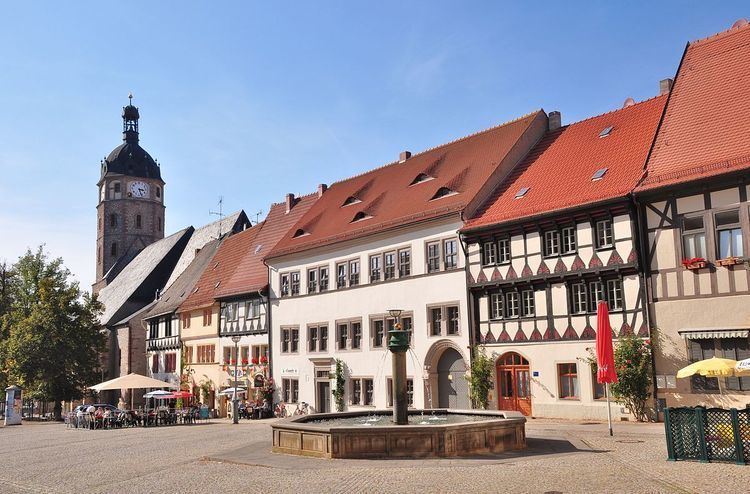District Mansfeld-Südharz Time zone CET/CEST (UTC+1/+2) Local time Tuesday 4:08 PM | Elevation 154 m (505 ft) Population 30,648 (31 Dec 2008) | |
 | ||
Weather 11°C, Wind W at 19 km/h, 72% Humidity Points of interest Europa‑Rosarium, Röhrigschacht, Spengler‑Museum, Wippra Dam, Moltke Watchtower | ||
Sangerhausen ( [zaŋɐˈhaʊzən]) is a town in Saxony-Anhalt, Germany, capital of the district of Mansfeld-Südharz, without being part of it. It is situated southeast of the Harz, approx. 35 kilometres (22 miles) east of Nordhausen, and 50 km (31 mi) west of Halle (Saale). About 31,000 people live in Sangerhausen.
Contents
- Map of Sangerhausen Germany
- History
- Municipality
- Main sights
- Twin towns Sister cities
- Sons and daughters of the town
- References
Map of Sangerhausen, Germany
History
Sangerhausen is one of the oldest towns in the historical region of Saxony-Anhalt, being mentioned in a document of 991 as appertaining to the estates of the emperor. By marriage it passed to the landgrave of Thuringia, and after 1056 it formed for a while an independent country. Having been again part of Thuringia, it fell in 1249 to Meissen, and in 1291 to Brandenburg. In 1372 it passed to the Electorate of Saxony and formed a portion of that territory until 1815, when it became a part of the Prussian Province of Saxony.
Municipality
The municipality of Sangerhausen currently includes the town itself plus 14 outlying villages, also called (in German) Ortschafte or Ortsteile. These are Breitenbach, Gonna, Grillenberg, Großleinungen, Horla, Lengefeld, Morungen, Oberröblingen, Obersdorf, Riestedt, Rotha, Wettelrode, Wippra and Wolfsberg.
In 1994, the town of Sangerhausen, at that time still an independent municipality, became part of the so-called Verwaltungsgemeinschaft Sangerhausen, a municipal association consisting of Sangerhausen itself and the two villages/municipalities Edersleben and Oberröblingen. On 29 April 2000 Edersleben left for the Verwaltungsgemeinschaft Helme. On 1 January 2005 the villages/municipalities Gonna, Grillenberg, Horla, Lengefeld, Morungen, Obersdorf, Pölsfeld, Rotha and Wettelrode joined the association from the Verwaltungsgemeinschaft Südharz which was dissolved. Six months later, on 3 July 2005 Pölsfeld left for the Verwaltungsgemeinschaft Allstedt-Kaltenborn.
On 1 Oct. 2005 the Verwaltungsgemeinschaft Sangerhausen, consisting then of 10 municipalities was dissolved and turned into the single town/municipality Sangerhausen; which meant that the 9 villages were truly annexed. On the same date Breitenbach, Großleinungen and Wolfsberg also joined, coming from the municipal association Roßla-Südharz. On 1 December 2005 Riestedt followed, coming from the Verwaltungsgemeinschaft Allstedt-Kaltenborn. Finally, Wippra was incorporated on 1 January 2008, coming from the Verwaltungsgemeinschaft Wipper-Eine.
Main sights
In the vicinity are the famous Kyffhäuser Monument and the Barbarossa Cave, the only anhydrite cave in Europe which can be visited by tourists. Sangerhausen is also home to the Europa-Rosarium, the largest collection of roses in the world, created in 1903.
Twin towns — Sister cities
Sangerhausen is twinned with:
